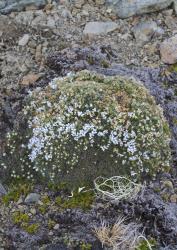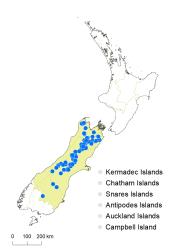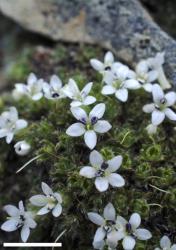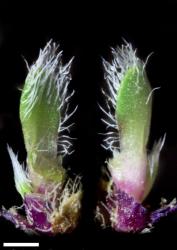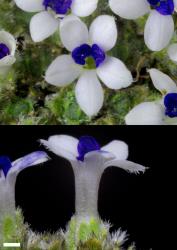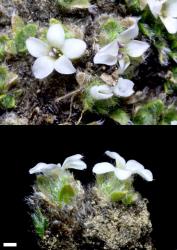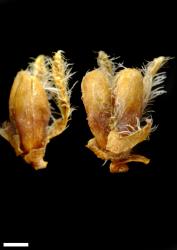- Taxon
- Gallery
- ≡ Pygmea pulvinaris Hook.f., Handb. New Zealand Fl. 217 (1864)
- ≡ Chionohebe pulvinaris (Hook.f.) B.G.Briggs & Ehrend., Contr. Herb. Austral. 25: 2 (1976)
- = Pygmea ciliolata var. pumila Ashwin in Allan, Fl. New Zealand 1, 874 & 975 (1961)
- ≡ Veronica ciliolata var. pumila (Ashwin) Garn.-Jones in Garnock-Jones et al., Taxon 56: 577 (2007)
- = Chionohebe ciliolata var. pumila nom. inval.
Dense cushion plant to 0.1 m tall. Stems erect, densely crowded, glabrous. Leaf bud indistinct, its outer leaves fully grown, diverging, sub-decussate, sub-erect to appressed, separating early; lamina thin, oblanceolate to narrowly obovate or spathulate, rarely lanceolate to narrowly ovate, 1.8–4.8 mm long, 0.5–2.0 mm wide, dull, pale green above and beneath in distal half, often brownish or yellowish at margins, pale green, white, or purplish at base; veins not evident; hairs stiff, eglandular: on adaxial surface isolated, scattered or in a central patch or covering upper half, rarely absent; on abaxial surface absent or scattered in upper half; margin ciliate, mostly distally, entire; apex obtuse, rarely sub-acute; base slightly narrowed; petiole absent. Inflorescence a solitary axillary bibracteate flower, female or male on separate plants, ♂ > ♀; bracts 2, opposite, very narrowly elliptic to narrowly oblanceolate, equalling and investing calyx; pedicel absent. Calyx lobes 5, obtuse to sub-acute, 1.6–3.3 mm long, equal, glabrous or sparsely eglandular-hairy outside and eglandular-ciliate. Corolla 2.5–5.0 (♀) or 4.0–7.0 (♂) mm diameter; tube white, 1.6–5.8 mm long, ≥ calyx, glabrous inside; lobes 5, white, spreading, equal, narrowly to very broadly elliptic or obovate, 1.0–2.5 mm long, obtuse to sub-acute, sometimes sparsely hairy near apex abaxially; nectar guides absent. Stamen filaments white, 0.2–0.8 mm long, anthers magenta or purple. Style glabrous, 2.3–7.0 mm long. Capsules angustiseptate, emarginate, eglandular-hairy especially at apex, 1–3 mm long, 1.2–2.7 mm at widest point. Seeds discoid to ellipsoid, weakly flattened, smooth, pale to dark brown, 0.6–0.9 mm long.
birleyi | spectabilis | trifida | densifolia | thomsonii | pulvinaris | chionohebe | ciliolata | |
|---|---|---|---|---|---|---|---|---|
Habit | lax sub-shrub | lax sub-shrub | lax sub-shrub | lax sub-shrub | cushion plant | cushion plant | cushion plant | cushion plant |
Stem hairs | eglandular & a few glandular, spreading | mixed glandular & eglandular, spreading | eglandular, retrorse | eglandular, retrorse | glabrous | glabrous | glabrous | glabrous |
Leaf size (mm) | 4.0–12 × 2.5–11 | 4.5–13 × 2.5–6.0 | 2–10 × 1–7 | 2–6.5 × 0.7–3 | 1.7–4.7 × 0.7–2.6 | 1.8–4.8 × 0.5–2 | 1.75–5 × 0.75–2.25 | 1.75–4.5 × 0.8–2.8 |
Leaf margins | deeply crenate to lobed | deeply crenate to lobed | shallowly toothed to lobed, rarely entire | usually entire, rarely 1–2 teeth or lobes | entire | entire | entire | entire |
Lamina | subcoriaceous, flat; margin not thickened, smooth | subcoriaceous, flat; margin not thickened, smooth | subcoriaceous, flat; margin not thickened, smooth | coriaceous, keeled, with thickened papillate margin | thin, flat; margin not thickened, smooth | thin, flat; margin not thickened, smooth | thin, flat; margin not thickened, smooth | thin, flat; margin not thickened, smooth |
Leaf hairs: adaxial | scattered eglandular | mixed eglandular & glandular | glabrous | glabrous | eglandular: in broad band across middle, occasionally scattered distally | eglandular appressed: scattered or in a central patch on distal half | absent | absent or isolated and scattered in distal ½ |
Leaf hairs: abaxial | scattered eglandular | mixed eglandular & glandular | glabrous | glabrous | glabrous, or stiff, eglandular, isolated distal hairs | glabrous or eglandular appressed scattered distally | absent or isolated in distal ½ | absent or isolated and scattered in distal ½ |
Leaf hairs: margin | eglandular-ciliate | mixed eglandular & glandular-ciliate | long glandular-ciliate | stiff eglandular-ciliate | ciliate in basal ⅔ with apical tuft | eglandular appressed: ciliate | absent or scattered cilia | ciliate throughout or in basal or distal half, usually with apical tuft |
Sexual system | cosexual | cosexual | cosexual | cosexual | dioecious | dioecious | dioecious | dioecious |
Inflorescence | 2–3 flowers, sometimes solitary bibracteolate | 2–3 flowers, sometimes solitary bibracteolate | 2–3 flowers, sometimes solitary bibracteolate | solitary bibracteolate | solitary bibracteolate | solitary bibracteolate | solitary bibracteolate | solitary bibracteolate |
Peduncle (mm) | 2–4 | 5–15 | 2–10 | 0 | 0 | 0 | 0 | 0 |
Pedicel (mm) | 0.3–1.5 | 2.5–5 | 0.5–7 | 0 | 0 | 0 | 0 | 0 |
Calyx lobes | 4 | 4 | 4 | 5 | 5 | 5 | 5 | 5 |
Corolla lobes | (4–)5(–6) | 4(–5) | 5(–6) | 5(–6) | 5 | 5 | 5 | 5 |
Corolla diameter (mm) | 7–10 | 18–25 | 15–20 | 7–16 | 2.5–5 | 2.5–6 | 1.5–4.1 | 2.1–6.5 |
Corolla shape | funnelform | funnelform | funnelform | funnelform | rotate | rotate | rotate | rotate |
Capsule size (mm) | 3–4 × 3–4 | 4–5 × 4–5 | 4.5–6 × 2.5–3 | 2.7–5 × 1.7–4.25 | 1.5–3 × 1–2 | 1–3 × 1.2–2.7 | 1.9–2.5 × 1.5–1.9 | 2.5–3.5 × 1.4–3.1 |
Capsule hairs | glabrous | mixed glandular & eglandular-hairy at apex | glandular-ciliate, sometimes glabrous | glabrous | glabrous to densely hairy at apex | eglandular-hairy, especially at apex | absent | absent or apical |
South Island: Western Nelson, Sounds Nelson (Mt Richmond only), Marlborough, Westland (near the Main Divide), Canterbury, Otago (Mt Ida, Mt St Bathans, Garvie Mountains).
Alpine cushion herb-field, fell-field, tussock grassland, on exposed ridges, outcrops, and cliffs, in rocky or stony sites and screes. Recorded elevations range from 762 to 2257 m.
Meudt & Bayly (2008) refer to plants at Mt Cook that appear intermediate between V. pulvinaris and both V. ciliolata and V. thomsonii. A hybrid between V. pulvinaris and the semi-whipcord hebe V. hookeri has also been recorded (Garnock-Jones & Lloyd 2004; Meudt & Bayly 2008).
Flowers: December–March (sometimes November); fruits: January–March (rarely November and December).
2n = 42 (Hair 1970, as Pygmea pulvinaris).
Veronica pulvinaris is classified in V. subg. Pseudoveronica sect. Hebe and informally in the “snow hebe” group (Albach & Meudt 2010). The cushion-forming snow hebes are probably very closely related. Their sessile, bibracteate, 5-merous flowers, almost actinomorphic corollas, and densely crowded, appressed leaves all support this hypothesis of relationship, which is weakly supported by DNA data. Their wider relationships are with a group of alpine sub-shrubs: V. birleyi, V. densifolia, V. spectabilis, and V. trifida.
The range of sizes of flowers and their parts is large, reflecting the differences between male and female flowers. Flowers on male plants are generally at the large end of the range of measurements given. They have well-formed, coloured anthers and broader corollas with longer tubes. Flowers on female plants are smaller in all their parts. Their anthers are very small and pale and contain no pollen.
It is unclear whether male plants set seed (gynodioecy) or not (dioecy). In recent field work at Mt Potts and Broken River ski field no female plants were observed, which could indicate that those populations are made up of hermaphrodite individuals.



